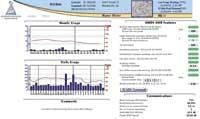Recent advances in wireless meter reading technology are opening the door to a bright future for utilities wanting deeper insights into the consumption habits of their customers and increased accuracy and timeliness of billing. New fixed-based AMR solutions coming onto the market can position utilities to address and overcome the challenges associated with AMR selection, deployment and support and also better prepare them for the future from both cost and performance perspectives.
While the shift to automatic meter reading was initially focused on eliminating the meter reader, the costly time interval between water delivery, consumption, billing and collections eventually became the central focus. This focus shift now continues toward the future coin of the realm: Information.
Moore’s Law & AMR
Forty years ago, a leading electronics magazine asked Intel co-founder Gordon Moore to write an article summarizing the state of the electronics industry. The article outlined what became known as “Moore’s Law,” the observation that the number of transistors on a chip can be doubled in a short period of time. That meant that the performance and capabilities of semiconductors were growing exponentially and would continue to do so well into the future.
When the article appeared, no one really believed the trend that Moore predicted could continue indefinitely. (In fact, even Moore himself would later express surprise about just how right he was!) However, as chip densities increased so did performance, which in turn, created broader and more diverse demand, and so on. Though AMR has certainly not progressed with the speed of integrated circuits, AMR solutions have become increasingly robust yet less expensive to purchase, install and maintain with each passing year.
Today, an expanding panorama of AMR technology is available to address the various challenges associated with water metering. Those challenges include meter design and cost; communications strategies; meter data acquisition; information storage and analysis; and of course, billing and collections.
The dominant wireless AMR infrastructure presently in place for the water industry uses drive-by technology. By contrast, more versatile fixed based networks have remained largely cost prohibitive and/or technically impractical - mainly because of high infrastructure costs required to extend their historically limited range.
However, recent advances in radio technology have dramatically extended the range of wireless AMR equipment in pit-set water meters and have reduced the number of collectors necessary to implement fixed based networks. With these changes in place, it is now possible to deliver the power and versatility of fixed based networks even more economically than drive-by systems.
Fixed based networks are attractive because data can be received from meters in real time. Drive-by systems, like the manual meter reading method it replaced, still only provide monthly data, whereas fixed based networks can provide a vastly richer stream of data in the form of hourly readings. This additional data opens the door for utilities to understand the consumption habits of customers much more accurately. Moreover, Time-of-Use (TOU) rates - a feature typically available only with high-end electric utility AMR systems - is easily accommodated.
These and other advanced capabilities are becoming particularly important in the western United States where water conservation efforts are increasingly stringent. New restrictions on customer water usage - such as daily or weekly irrigation schedules for lawns and grounds - are now becoming quite prevalent. The monitoring and policing of these restrictions is always difficult and time-consuming and in some cases, virtually impossible. Modern fixed based network water AMR systems, however, can support automatic real-time code violation detection and reporting to support the enforcement of what have become vital conservation initiatives.
Billing time cycles can also be greatly streamlined with fixed based networks, with bills being generated from reads taken earlier in the same day rather than having to wait for meter reading data dumps from hand-held readers or drive-by vans. Instead, the latest data is always instantly available from on-line databases. Also, fixed based networks allow monitoring of real-time events (e.g., leak detection, broken pipe detection, etc.) with alerts generated and sent directly to water distribution maintenance personnel. Other trouble events such as back flow detection, open wires, and meter tampering can also be reported in real-time.
The screen shot illustrates the diverse and comprehensive array of information that can be made available with a fixed based network approach to AMR. As this illustration depicts, modern scalable fixed based AMR networks for the water market are inherently equipped to meet not only today’s needs but also those coming in the future.
About the Author
Marc Reed, Vice President Software & Systems, is a founding principal of AMDS and has over 18 years experience in systems, software and hardware designs. Since the beginning of his career at Dallas-based defense contractor E-Systems, Reed has specialized in the design and implementation of wireless data links. Advanced Metering Data Systems provides automatic meter reading, wireless connectivity and monitoring services to electric, gas and water utilities using patented technology and a dedicated, FCC-licensed fixed wireless network. www.amdswireless.com.




